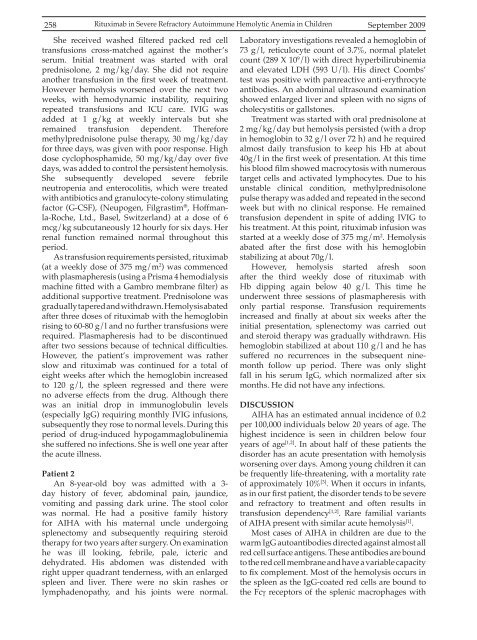Vol 41 # 3 September 2009 - Kma.org.kw
Vol 41 # 3 September 2009 - Kma.org.kw
Vol 41 # 3 September 2009 - Kma.org.kw
Create successful ePaper yourself
Turn your PDF publications into a flip-book with our unique Google optimized e-Paper software.
258<br />
Rituximab in Severe Refractory Autoimmune Hemolytic Anemia in Children<br />
She received washed filtered packed red cell<br />
transfusions cross-matched against the mother’s<br />
serum. Initial treatment was started with oral<br />
prednisolone, 2 mg/kg/day. She did not require<br />
another transfusion in the first week of treatment.<br />
However hemolysis worsened over the next two<br />
weeks, with hemodynamic instability, requiring<br />
repeated transfusions and ICU care. IVIG was<br />
added at 1 g/kg at weekly intervals but she<br />
remained transfusion dependent. Therefore<br />
methylprednisolone pulse therapy, 30 mg/kg/day<br />
for three days, was given with poor response. High<br />
dose cyclophosphamide, 50 mg/kg/day over five<br />
days, was added to control the persistent hemolysis.<br />
She subsequently developed severe febrile<br />
neutropenia and enterocolitis, which were treated<br />
with antibiotics and granulocyte-colony stimulating<br />
factor (G-CSF), (Neupogen, Filgrastim ® , Hoffmanla-Roche,<br />
Ltd., Basel, Switzerland) at a dose of 6<br />
mcg/kg subcutaneously 12 hourly for six days. Her<br />
renal function remained normal throughout this<br />
period.<br />
As transfusion requirements persisted, rituximab<br />
(at a weekly dose of 375 mg/m 2 ) was commenced<br />
with plasmapheresis (using a Prisma 4 hemodialysis<br />
machine fitted with a Gambro membrane filter) as<br />
additional supportive treatment. Prednisolone was<br />
gradually tapered and withdrawn. Hemolysis abated<br />
after three doses of rituximab with the hemoglobin<br />
rising to 60-80 g/l and no further transfusions were<br />
required. Plasmapheresis had to be discontinued<br />
after two sessions because of technical difficulties.<br />
However, the patient’s improvement was rather<br />
slow and rituximab was continued for a total of<br />
eight weeks after which the hemoglobin increased<br />
to 120 g/l, the spleen regressed and there were<br />
no adverse effects from the drug. Although there<br />
was an initial drop in immunoglobulin levels<br />
(especially IgG) requiring monthly IVIG infusions,<br />
subsequently they rose to normal levels. During this<br />
period of drug-induced hypogammaglobulinemia<br />
she suffered no infections. She is well one year after<br />
the acute illness.<br />
Patient 2<br />
An 8-year-old boy was admitted with a 3-<br />
day history of fever, abdominal pain, jaundice,<br />
vomiting and passing dark urine. The stool color<br />
was normal. He had a positive family history<br />
for AIHA with his maternal uncle undergoing<br />
splenectomy and subsequently requiring steroid<br />
therapy for two years after surgery. On examination<br />
he was ill looking, febrile, pale, icteric and<br />
dehydrated. His abdomen was distended with<br />
right upper quadrant tenderness, with an enlarged<br />
spleen and liver. There were no skin rashes or<br />
lymphadenopathy, and his joints were normal.<br />
<strong>September</strong> <strong>2009</strong><br />
Laboratory investigations revealed a hemoglobin of<br />
73 g/l, reticulocyte count of 3.7%, normal platelet<br />
count (289 X 10 9 /l) with direct hyperbilirubinemia<br />
and elevated LDH (593 U/l). His direct Coombs’<br />
test was positive with panreactive anti-erythrocyte<br />
antibodies. An abdominal ultrasound examination<br />
showed enlarged liver and spleen with no signs of<br />
cholecystitis or gallstones.<br />
Treatment was started with oral prednisolone at<br />
2 mg/kg/day but hemolysis persisted (with a drop<br />
in hemoglobin to 32 g/l over 72 h) and he required<br />
almost daily transfusion to keep his Hb at about<br />
40g/l in the first week of presentation. At this time<br />
his blood film showed macrocytosis with numerous<br />
target cells and activated lymphocytes. Due to his<br />
unstable clinical condition, methylprednisolone<br />
pulse therapy was added and repeated in the second<br />
week but with no clinical response. He remained<br />
transfusion dependent in spite of adding IVIG to<br />
his treatment. At this point, rituximab infusion was<br />
started at a weekly dose of 375 mg/m 2 . Hemolysis<br />
abated after the first dose with his hemoglobin<br />
stabilizing at about 70g/l.<br />
However, hemolysis started afresh soon<br />
after the third weekly dose of rituximab with<br />
Hb dipping again below 40 g/l. This time he<br />
underwent three sessions of plasmapheresis with<br />
only partial response. Transfusion requirements<br />
increased and finally at about six weeks after the<br />
initial presentation, splenectomy was carried out<br />
and steroid therapy was gradually withdrawn. His<br />
hemoglobin stabilized at about 110 g/l and he has<br />
suffered no recurrences in the subsequent ninemonth<br />
follow up period. There was only slight<br />
fall in his serum IgG, which normalized after six<br />
months. He did not have any infections.<br />
DISCUSSION<br />
AIHA has an estimated annual incidence of 0.2<br />
per 100,000 individuals below 20 years of age. The<br />
highest incidence is seen in children below four<br />
years of age [1,2] . In about half of these patients the<br />
disorder has an acute presentation with hemolysis<br />
worsening over days. Among young children it can<br />
be frequently life-threatening, with a mortality rate<br />
of approximately 10% [3] . When it occurs in infants,<br />
as in our first patient, the disorder tends to be severe<br />
and refractory to treatment and often results in<br />
transfusion dependency [1,2] . Rare familial variants<br />
of AIHA present with similar acute hemolysis [1] .<br />
Most cases of AIHA in children are due to the<br />
warm IgG autoantibodies directed against almost all<br />
red cell surface antigens. These antibodies are bound<br />
to the red cell membrane and have a variable capacity<br />
to fix complement. Most of the hemolysis occurs in<br />
the spleen as the IgG-coated red cells are bound to<br />
the Fcγ receptors of the splenic macrophages with
















